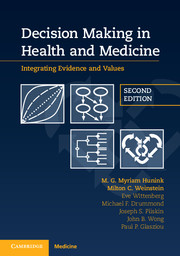Book contents
- Frontmatter
- Dedication
- Contents
- Foreword
- Foreword to the first edition (2001)
- Preface
- Acknowledgments
- list of Abbreviations
- About the authors
- 1 Elements of decision making in health care
- 2 Managing uncertainty
- 3 Choosing the best treatment
- 4 Valuing outcomes
- 5 Interpreting diagnostic information
- 6 Deciding when to test
- 7 Multiple test results
- 8 Finding and summarizing the evidence
- 9 Constrained resources
- 10 Recurring events
- 11 Estimation, calibration, and validation
- 12 Heterogeneity and uncertainty
- 13 Psychology of judgment and choice
- Index
- References
12 - Heterogeneity and uncertainty
Published online by Cambridge University Press: 05 October 2014
- Frontmatter
- Dedication
- Contents
- Foreword
- Foreword to the first edition (2001)
- Preface
- Acknowledgments
- list of Abbreviations
- About the authors
- 1 Elements of decision making in health care
- 2 Managing uncertainty
- 3 Choosing the best treatment
- 4 Valuing outcomes
- 5 Interpreting diagnostic information
- 6 Deciding when to test
- 7 Multiple test results
- 8 Finding and summarizing the evidence
- 9 Constrained resources
- 10 Recurring events
- 11 Estimation, calibration, and validation
- 12 Heterogeneity and uncertainty
- 13 Psychology of judgment and choice
- Index
- References
Summary
Medicine is a science of uncertainty and an art of probability.
Sir William OslerIntroduction
Decision trees and Markov cohort models, as described and illustrated in the previous chapters, are essentially macrosimulation models. Such models simulate cohorts or groups of subjects. A number of limitations exist to the use of these models. Markov cohort models, for example, have ‘no memory’, implying that subjects in a particular state are a homogeneous group. Techniques to overcome these limitations, such as expanding the number of states, using tunnel states, or using alternative modeling techniques, were discussed in Chapter 10. These techniques can get very complex when dealing with extensive heterogeneity within a population. Microsimulation using Monte Carlo analysis provides another powerful technique to account for heterogeneity across subjects. Microsimulation with Monte Carlo analysis was introduced in Chapter 10 as an alternative method for evaluating a Markov model. In this chapter it will be discussed at greater length in the context of simulating heterogeneity.
In the previous chapters we represented uncertainty with probabilities. Implicitly the assumption was that, even though we were unsure of whether an event would take place, we could nevertheless predict or estimate the probability (or relative frequency) that it would occur. In essence we were using deterministic models. In reality, however, we are also uncertain of the degree of uncertainty. In other words, rather than dealing with a fixed probability we are actually dealing with a distribution of possible values of probabilities. Not only are we uncertain about the probabilities we use in our models, but we are also uncertain about the effectiveness outcomes and cost estimates included in the analysis. Thus, every parameter value we enter into our models is better represented as a probabilistic variable rather than a deterministic variable. If there is a single uncertain parameter, e.g., the relative risk reduction of an intervention, then the 95% confidence interval (CI) of this parameter is commonly used to indicate the uncertainty of the effect. Uncertainty in two or more components requires more complex methods, such as Monte Carlo probabilistic sensitivity analysis, which we will also discuss in this chapter.
- Type
- Chapter
- Information
- Decision Making in Health and MedicineIntegrating Evidence and Values, pp. 356 - 391Publisher: Cambridge University PressPrint publication year: 2014
References
Accessibility information
- 1
- Cited by

